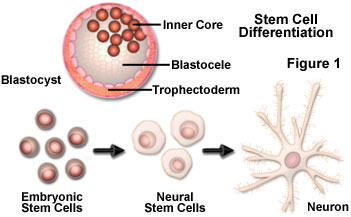Embyronic stem cell lines, which were originally produced from the inner core of human blastocysts as well as those of other mammals, are now widely established in the research community using traditional in vitro culture. The cell lines preserve their undifferentiated state and normal nuclei during subculture, however, they remain capable of differentiation into virtually any type of tissue. Proliferated embyronic stem cells first become stem cells (such as neuronal stem cells, muscle stem cells, vascular endothelial stem cells, and hematopoietic stem cells) according to the specific culture conditions, and then differentiate into neurons, muscle cells, vascular endothelial cells and blood cells. However, unlike the fertilized egg, a cluster of embyronic stem cells cannot independently develop into a human being (or other animal).

The potential is enormous for embyronic stem cells to make a significant contribution in the biomedical and medical sciences as well as clinical applications. In the research arena, stem cell cultures can be used to locate various molecules and genes engaged in the proliferation and differentiation of a wide variety of cell types. In the field of medicine, the cells are expected to be useful in the development of artificial organs and in cell transplantation. The contribution of embyronic stem cell research to organ transplantation is expected to be beneficial in blood transfusion as well as to advance the treatment of Alzheimer’s disease, myocardial infarction, angiopathy, and muscular dystrophy.
The introduction of exogeneous genes into embyronic stem cells can be easily conducted for purposes such as the removal of gene function in cells, the introduction of mutation, and gene replacement. This technique also makes it possible to create a knockout animal that destroys the function of a specific gene. Future research will enable researchers to transplant human nuclei into embyronic stem cells in order to create an organ dedicated for a specific patient. Research into embyronic stem cell strains is more advanced in mice than in humans, however, both human and animal stem cell strains have already been established. Since it is no longer merely a dream to create human clones using embyronic stem cell techniques, ethical issues are currently under discussion.
Application of Stem Cell Research in the Creation of Chimera Animals
Chimeras, animals whose cells are derived both from the original embryos and from mutation-introduced embyronic stem cells, can be created by manipulating genes to introduce a mutation into embyronic stem cells and then returning the cells to the early embryos. The target mutant can be obtained by selecting animals having germ cells derived from the embyronic stem cells. Knockout animals that delete the function of a specific gene can also be created using the same techniques.
Subculture of Stem Cells Perserving the Undifferentiated State
Strains of embyronic stem cells are readily created by removing and cultivating the inner core of the blastocyst from a fertilized ova. In fact, mouse embyronic stem cells are now available commercially. Subculture of embyronic stem cells requires feeder cells, which release Leukemia Inhibitory Factor (LIF), the factor required to preserve the embyronic stem cells in their undifferentiated state. If LIF is added directly into the culture medium, the embyronic stem cells can be preserved in an undifferentiated state without the feeder cells.



